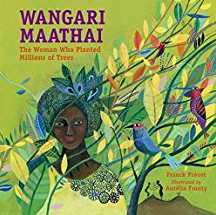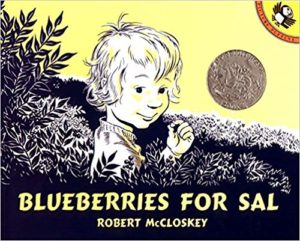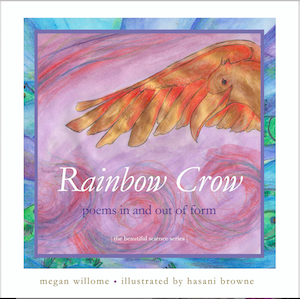Two years ago I moved across town and wrote blog posts saying goodbye to my maple tree and live oak. This new, smaller yard has a cedar elm and a burr oak. On Earth Day, shortly after we moved in, we planted a redbud tree. It took a year before we knew if it had taken root — for months it was just a slowly growing stick. But last year it got leaves, and this year it got pink-red buds. Every morning when the dogs and I return from our walk, I dump out the leftover water from their bowl onto the tree. It’s already taller than I am.
“A tree is a little bit of the future,” the text says in Wangari Maathai: The Woman Who Planted Millions of Trees by Franck Prevot, illustrated by Aurélia Fronty.
This picture book biography is about Wangari Maathai, who won the Nobel Peace Prize in 2004. The book includes a bibliography, a timeline, a map, and quotations from both Maathai’s autobiography, Unbowed, and from her Nobel lecture. The book won the 2016 Children’s Africana Book Award.
When Maathai was growing up in Kenya, in a Kikuyu community, one of her chores was to gather firewood. But her mother made sure she did not gather wood from the fig tree. In a 2006 interview at On Being, Maathai said her mother gave this explanation:
That is a tree of God. We don’t cut it. We don’t burn it. We don’t use it. They live for as long as they can, and they fall on their own when they are too old.”
Only later did Maathai understand one of the vital services those uncut trees provided: They prevented landslides. It was one way she learned how an environmental issue is often a human issue. Maathai would spend her life fighting tyranny by planting trees.
Early in the story we learn that British colonists cut down trees in Kenya to plant tea. (Tea remains a major Kenyan export.) Prevot writes, “Wangari remembers the first trees she saw fall.”
The book chronicles Maathai’s education — some of which took place in the United States — and her return to Kenya. She finds the colonists have gone, but the people are still not free. They continue to suffer because the lack of trees affects the animals, the rivers, the soil, the women who gather water, and the children who gather firewood.
The country is free, but the trees are not — they still cannot grow in peace.”
So Maathai plants trees. She starts by planting seven; five die. She does not give up. The Green Belt Movement she began has resulted in the planting of more than 52 million trees.
Although this picture book is a biography, it’s illustrated more like a fairy tale. The color-full images evoke emotion rather than solely convey facts. Some of the illustrations are a bit surreal.
For example, in the pages that describe Maathai’s Green Belt Movement, the people are drawn elongated, each with a bird atop his or her head. From these figures three pen-and-ink birds emerge, as if they are an entirely new species — perhaps birds of peace that can neither be contained nor explained.
Trees are hideouts for insects and provide inspiration for poets.”
The world needs trees. The world needs insects. The world needs poets, and some of them will write about trees.
Trees
I think that I shall never see
A poem lovely as a tree.
A tree whose hungry mouth is prest
Against the earth’s sweet flowing breast;
A tree that looks at God all day,
And lifts her leafy arms to pray;
A tree that may in Summer wear
A nest of robins in her hair;
Upon whose bosom snow has lain;
Who intimately lives with rain.
Poems are made by fools like me,
But only God can make a tree.
—Joyce Kilmer, published 1914
During Poetic Earth Month, L.L. Barkat wrote about this picture book and said that discussions about climate change would be more productive if they were framed around love. “But hardly anyone talks about it this way,” she writes.
Maathai did. She loved trees and people, insects and poets. She knew trees are not only good for the earth but also for the human spirit. The trees bear witness to her legacy.
_______________
The next Children’s Book Club will meet Friday, July 12. We will read Blueberries for Sal by Robert McCloskey.
Photo by Marvin Foushee, Creative Commons, via Flickr. Post by Megan Willome.
Browse more Children’s Book Club
“Megan Willome has captured the essence of crow in this delightful children’s collection. Not only do the poems introduce the reader to the unusual habits and nature of this bird, but also different forms of poetry as well.”
—Michelle Ortega, poet and children’s speech pathologist
- Perspective: The Two, The Only: Calvin and Hobbes - December 16, 2022
- Children’s Book Club: A Very Haunted Christmas - December 9, 2022
- By Heart: ‘The night is darkening round me’ by Emily Brontë - December 2, 2022




L.L. Barkat says
Inspiring, Megan.
Because these issues are about, as Bethany has so aptly put it, our environment, I really see how they are always a human issue. Sometimes we simply aren’t wise enough to see beyond the next 5 minutes. 😉
And this is such a great moment: “Maathai would spend her life fighting tyranny by planting trees.” I wish more people would “fight” with life-giving means.
Also? I love, love, love that you wrote goodbye to your trees. 🙂
This, too: “perhaps birds of peace that can neither be contained nor explained.” Peace has a glorious uncontainability about it.
Megan Willome says
I was really taken with the art in the book. Thanks so much for drawing my attention to it at Poetic Earth Month. And that gave me the opportunity to re-listen to that On Being interview with Wangari Maathai.
L.L. Barkat says
I had never heard it before (listening now).
One of the outstanding moments so far: “You start to wonder how that simple equation was broken apart.” [KT] And then Maathai’s observation that we accept progress as progress but sometimes that’s not all good and “we begin to see how things have become disconnected and now the challenge is to see how can you connect them again, how can you make people see the linkages.”
(Also interesting that her Catholic background created a sense of *service* in her.)
Thank you for being a part of recreating the links, Megan.
LW Willingham says
This might be the first poem I knew as a poem, and memorized. Thanks, 6th grade teacher Mr. Palm. 🙂
For some reason, here’s the striking thing about this story: so much of the time we are talking about the relationship between trees and carbon. But here, the loss of trees was the cause of landslides. Much more visible, tangible, undeniable. I know people are talking about these things, but I wonder if we heard about the other roles of trees even more…
Megan Willome says
I second your motion for a more complete view of trees and the roles they serve.
And I love that your sixth-grade teacher made you learn that poem.
Bethany R. says
Beautiful post and discussion. I’m struck by Maathai’s mother’s words–how she made sure to emphasize the importance of the tree and clarify the boundaries around it to her kids.
LW, great point about the variety of help trees give our world.
Megan Willome says
Bethany, we never know the power of a mother’s words.